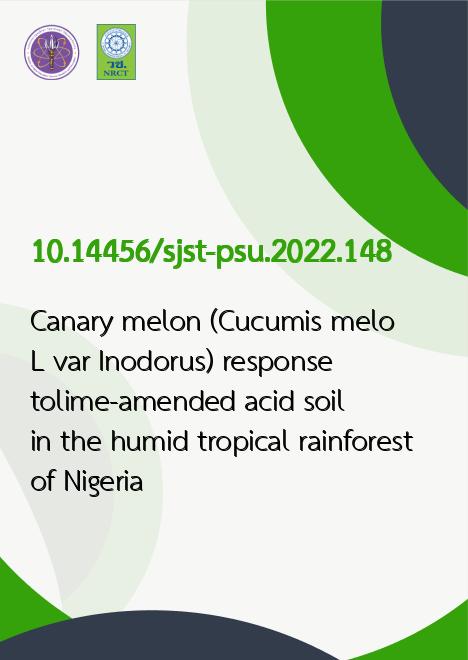
|
Canary melon (Cucumis melo L. var. Inodorus) response tolime-amended acid soil in the humid tropical rainforest of Nigeria |
|---|---|
| รหัสดีโอไอ | |
| Creator | 1. Ekemini Obok 2. Emmanuel Macha 3. Francis Nwagwu 4. Donatus Uwah |
| Title | Canary melon (Cucumis melo L. var. Inodorus) response tolime-amended acid soil in the humid tropical rainforest of Nigeria |
| Publisher | Research and Development Office, Prince of Songkla University |
| Publication Year | 2565 |
| Journal Title | Songklanakarin Journal of Science an Technology (SJST) |
| Journal Vol. | 44 |
| Journal No. | 4 |
| Page no. | 1145-1152 |
| Keyword | Cucumis melo, cucurbits, lime, soil acidity, yield traits |
| URL Website | https://rdo.psu.ac.th/sjst/index.php |
| ISSN | 0125-3395 |
| Abstract | Preliminary field experiments were conducted to examine the influences of lime (CaCO3) rate (0, 1, 2, 3, 4, and 5t ha-1) on the production of canary melon (Cucumis melo L. var. Inodorus) on acidic soil of Calabar, Nigeria. Canary melonproduction is presently limited to the northern part of Nigeria. The southern part of Nigeria has the potential to support itsproduction, but for low soil pH. The experiment was laid out in a randomised complete block design with three replicates. Theinitial soil pH (1:2.5 H2O), 4.13, was improved to 4.69 (1 t ha-1) โ" 5.93 (5 t ha-1). There was no significant difference (p > 0.05) insoil pH increase after 2 t ha-1 of CaCO3. Liming significantly (p โค 0.05) increased available P, total N, Ca2+, Mg2+, K+, effectivecation exchange capacity, and base saturation of the soil, but reduced exchangeable acidity. Increased lime rates increased (p โค0.05) seedling emergence, leaf (area, area index), vine (length and thickness), and fruit and seed yields. However, fruitssweetness was inconsistent. CaCO3 had significant (p โค 0.001) linear relationships and correlations with growth and yield traitsof canary melon. Canary melon can be cultivated in Calabar with an application of 2 โ" 5 t ha-1 of CaCO3. |
